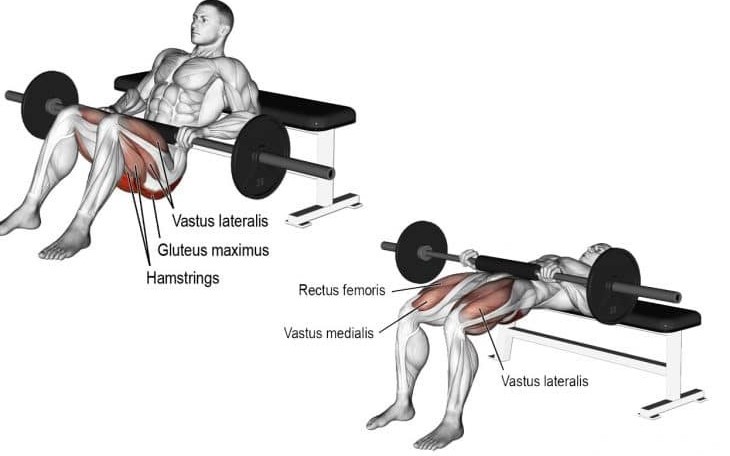BOURSESSENEGAL – Hip thrusts have taken the fitness world by storm. This powerful exercise focuses on your glutes, hamstrings, and core, making it a fantastic choice for anyone looking to enhance their strength and aesthetics. Whether you want to build a stronger posterior or improve your overall athletic performance, hip thrusts are a must in your workout routine. In this comprehensive guide, we’ll explore the benefits, proper techniques, variations, and tips for incorporating hip thrusts into your training regimen.
What Are Hip Thrusts?
Hip thrusts are a strength training exercise that targets the glute muscles. Unlike squats or deadlifts, hip thrusts isolate the glutes more effectively, allowing you to focus on this specific area. By using your body weight or adding resistance, you can progressively overload your muscles, which leads to increased strength and muscle growth over time.
Benefits of Hip Thrusts
The benefits of hip thrusts are numerous. Here are some key advantages:
1. Glute Development
Hip primarily target the gluteus maximus, which is crucial for overall strength and aesthetics. Strong glutes contribute to better athletic performance and improved posture.
2. Injury Prevention
By strengthening the glutes, hip help stabilize the pelvis and lower back, reducing the risk of injuries. This stability is essential for activities like running, jumping, and lifting.
3. Enhanced Athletic Performance
Whether you play sports or engage in fitness activities, strong glutes are vital. Hip improve explosive power, speed, and overall performance in various sports.
4. Improved Posture
Strong glutes support the spine and pelvis, leading to better posture. Improved posture reduces strain on the lower back and enhances overall body alignment.
5. Versatile Exercise
Hip can be modified to suit various fitness levels. You can perform them with just your body weight or add resistance with weights, bands, or even a barbell.
How to Perform Hip Thrusts
To get the most out of hip , it’s crucial to execute the movement correctly. Follow these steps for proper technique:
1. Set Up Your Position
- Equipment Needed: You can perform hip with a bench or sturdy surface. If you’re using a barbell, ensure it’s loaded with an appropriate weight.
- Starting Position: Sit on the ground with your upper back against a bench. Roll the barbell over your legs so that it rests on your hips. Your feet should be flat on the ground, about shoulder-width apart.
2. Engage Your Core
Before lifting, engage your core by tightening your abdominal muscles. This step helps protect your lower back during the movement.
3. Lift Your Hips
Push through your heels and thrust your hips upward. Squeeze your glutes at the top of the movement. Your body should form a straight line from your shoulders to your knees.
4. Lower and Repeat
Lower your hips back down towards the ground while maintaining control. Avoid letting your back sag; instead, focus on using your glutes to control the movement. Repeat for the desired number of reps.
5. Breathing
Breathe out as you lift your hips and inhale as you lower them back down.
Common Mistakes to Avoid
To maximize the effectiveness of hip thrusts and avoid injury, be mindful of these common mistakes:
1. Not Engaging the Glutes
Many people rely too much on their lower back instead of using their glutes. Focus on squeezing your glutes throughout the movement to ensure proper engagement.
2. Using Excessive Weight
While it’s essential to challenge yourself, using too much weight can lead to poor form. Start with a manageable weight and increase it gradually as you build strength.
3. Improper Foot Placement
Ensure your feet are flat on the ground and positioned at an appropriate distance from your body. Too close or too far can affect your leverage and make the exercise less effective.
4. Rounding the Back
Keep your back straight and your core engaged throughout the movement. Avoid rounding your back, as this can lead to injury.
Variations of Hip Thrusts
Once you master the basic hip thrust, you can explore several variations to keep your workouts fresh and challenging.
1. Single-Leg Hip Thrusts
Performing hip thrusts on one leg adds an element of instability and increases the demand on your glutes. This variation also helps improve balance and coordination.
2. Weighted Hip Thrusts
Adding weight can significantly increase the intensity of the exercise. Use a barbell, dumbbells, or resistance bands to challenge yourself further.
3. Banded Hip Thrusts
Placing a resistance band around your knees during hip can help activate your glutes even more. The band adds lateral resistance, requiring your glutes to work harder.
4. Elevated Hip Thrusts
Using a higher surface for your shoulders can increase the range of motion. This variation can lead to more significant glute activation.
Tips for Incorporating Hip Thrusts into Your Routine
1. Warm-Up
Always warm up before your workouts. Consider doing dynamic stretches or light cardio to prepare your muscles.
2. Start Slow
If you’re new to hip thrusts, start with bodyweight exercises to master the form before adding weights.
3. Track Your Progress
Keep a journal or use fitness apps to track your weights and reps. This practice will help you stay motivated and see your improvements.
4. Listen to Your Body
Pay attention to how your body responds. If you feel any discomfort or pain, adjust your form or the weight you’re using.
5. Stay Consistent
Like any exercise, consistency is key to seeing results. Incorporate hip thrusts into your routine 1-2 times a week for optimal gains.
Conclusion
Hip thrusts are an incredibly effective exercise for developing strength and aesthetics in your glutes. By mastering the proper technique and incorporating variations into your workouts, you can enhance your performance and prevent injuries. Remember to stay consistent, track your progress, and most importantly, enjoy the journey toward building a stronger posterior. Start adding hip to your routine today and reap the rewards!
REFERENCE : https://www.health.com/



